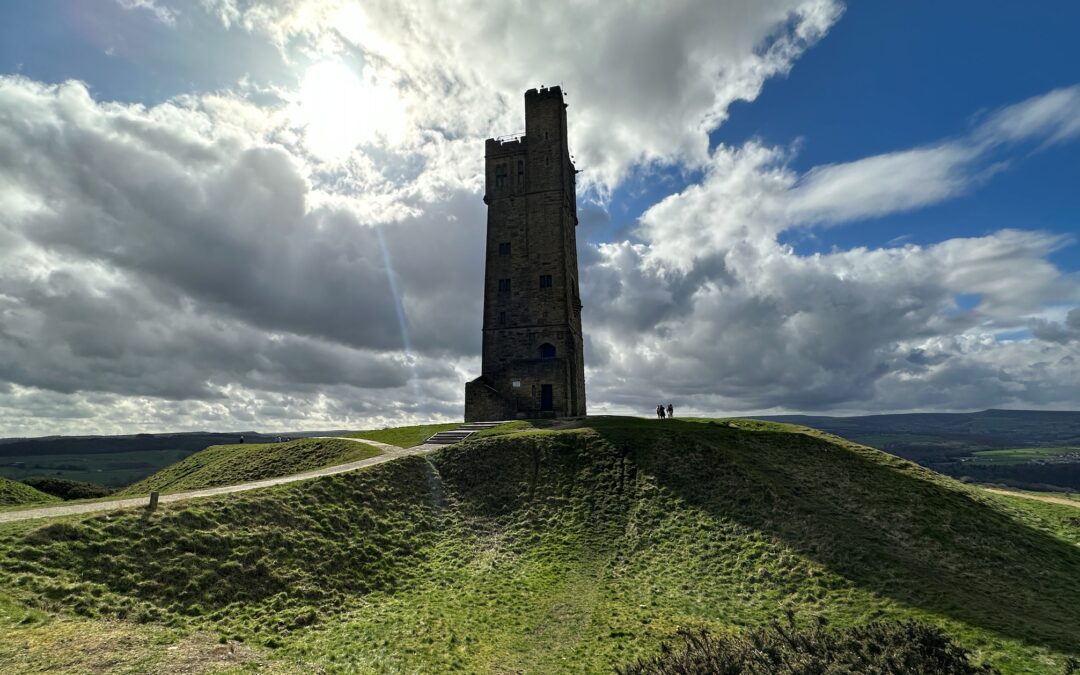Just to the South of Huddersfield on a raised area of land near Almondsbury lies Castle Hill. Perched on top of the hill is Victoria Tower, a Victorian monument which has become perhaps Huddersfield’s most recognisable monument and can be seen from miles around.
I had seen it from afar many times but with a rare day off and having found a circular walk around the area from the summit, I thought I would go and see it up close and personal so set out with my wife and dog to explore.
I had done some research before arriving and was aware that the site was the former home of an iron age hill fort in existence way before the Romans arrived in England. But having read the various information boards around the site and done some further reading, I found that Castle Hill has a unique and varied story.
The hill itself has a hard gritstone cap, a coarse sandstone with layers of shale and sandstone alternating below. The gritstone cap had protected the hill from erosion.
The Yorkshire Geologist and Archaeologist William J. Varley carried out excavations over a 30 year period between 1939 and 1972 (with a break during the 2nd World War) and much of what we know now is down to him.
His research showed that the Hill had been an important site during several key periods but interspersed with long periods of being un-inhabited. What was particularly useful in Varley’s digs was that he was able to radio carbon date the findings to allow timeframes to be applied to the occupations.
The earliest settlers dated back to 2151 BC, during the Neolithic or new stone age with some evidence of shelters and some basic enclosure. They would have been attracted to the high ground as the lower ground would have been prone to flooding.
The next evidence of settlement seems to come during the Iron Age which is generally recognised as having started in England around 750 BC. Around 590 BC a fort was built covering 5 acres on the top of the hill. There was a defensive ditch, a palisade fence and a timber, rock and clay tower.
The excavations showed the tower had burnt down and the original theory was that it must have been the Romans fault. But the carbon dating showed the tower having been burnt down around 430 BC way before the Romans invaded and it appears the fire was started accidentally.
Where folklore had said that Castle Hill may have been home to Queen Cartimundua, one of the Queen of the Brigantes, a northern Iron age tribe who built up relations with the Romans, this has now been discounted as the site appeared to have been deserted by iron age settlers over 500 years before the Romans arrived in Yorkshire.
Fast forward now to 1066 and the Norman Conquest. Much of the land in the area had been given by William the Conqueror to the de Lacy family whose main base was Pontefract Castle. We know the family built a motte and bailey castle on the site to control the surrounding area. The castle was also used as a hunting lodge.
A well from this period exists just behind the tower.
It then looks like the castle was destroyed in the 1340’s as it had come under the ownership of the Earl of Lancaster. He was executed by his cousin Kind Edward II for treason with his lands reverting back to the king’s ownership.
Another 500 years passes before the next bit of history for the site is recorded. In 1810 a small alehouse was built on the hill. This was later taken over by the Temperance Movement and turned into a Temperance Hotel – think a pub which rather than selling beer and spirits sells hot chocolate, cordial and non-alcoholic drinks! In the 1850’s a large hotel and pub was built to replace this and called the Castle Hill Hotel.
A bowling green was added outside the hotel and many events took place at the site from political rallies to prize fights.
In the 1890’s a number of local dignitaries put forward the idea of building a tower to celebrate Queen Victoria’s 60 years on the throne and her forthcoming diamond jubilee.
Work was started in 1898 and the tower was completed in 1899. The tower was opened by the Earl of Scarborough on 24th June 1899. Over 20,000 people attended the opening of the tower and a choir of 40 local singers sang hymns from the top of the tower. Sadly it was so windy apparently no one on the ground could hear the singers.
Originally the tower was called the Jubilee Tower but the Queen herself gave permission to change the tower’s name to the Victoria Tower.
Sadly in the November of its opening year, a Mr Edgar North fell to his death from the tower. At first suicide was suspected but eventually it was put down to a tragic accident as it was found that Mr North had drunk 5 “3 penny specials” in the Castle Hill Hotel before climbing the tower – each 3 penny special consisted of two beers and three whiskies!
We know that at various points in Castle Hill’s history that there has been a beacon which has been lit as a warning system. In 1588 it was lit to warn of the Spanish Armada but even in modern times a beacon is erected to celebrate events such as VE day celebrations in 1995 and to celebrate the late Queen’s Platinum jubilee.
As a nod to this, to celebrate the silver jubilee of Queen Elizabeth II in 1977, a lantern was installed on the tower paid for by public subscription on an appeal by Huddersfield Civic Society.
I also found out that the Victoria tower was nearly demolished during the war as it was believed the Germans were using it for navigation. Luckily it survived.
I noticed on my visit that there is no longer a hotel on the site and found out that the owners had applied to renovate and expand the Castle Hill Hotel and planning permission granted. But it became apparent that work being carried out was in excess of what had been agreed and the work was forced to stop by the council. The original hotel had all but been demolished by that time.
Eventually there was so much public opinion against any further building on the site by local Civic Societies, Archaeological groups and the general public that the project was abandoned. Don’t despair, there are a couple of great pubs in Almondbury!
The site is now a scheduled monument and is protected by law as an archaeological site of national importance. It’s definitely worth a visit for the fantastic views and don’t forget to explore the many foot paths around the site.
Article contributed by Tim Barber – https://realyorkshiretours.co.uk/



